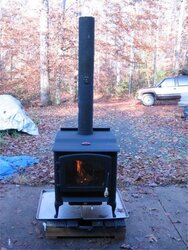As important as draft obviously is, I have a question. Does this mean if you put a stove in the back yard, with no flue pipe whatsoever, you would not be able to burn a load of wood in it? What would, or would not happen? Obviously you would be able to burn a load of wood in it. So, what is the scientific necessity of strong draft? It seems to be the necessity of getting air through multiple passageways in newer stove designs. In both old and some new stove designs air inlets are just right there, an opening on the door, or top of the stove or something. Open the draft, look inside the stove, see the flames.
I can see how strong flue sucking is necessary to draw air through all the tunnels into the firebox in newer stoves for cleaner glass, and now secondary combustion.
I can see how strong flue sucking is necessary to draw air through all the tunnels into the firebox in newer stoves for cleaner glass, and now secondary combustion.


 So, what is the scientific necessity of strong draft?
So, what is the scientific necessity of strong draft?